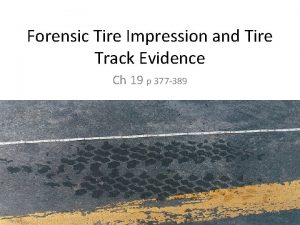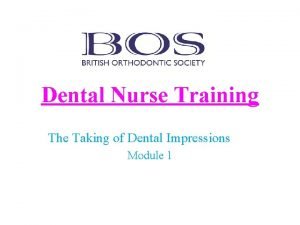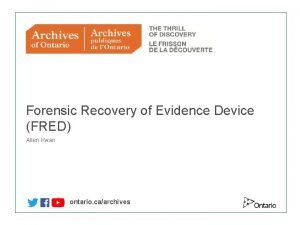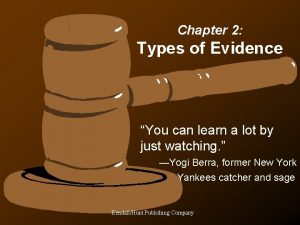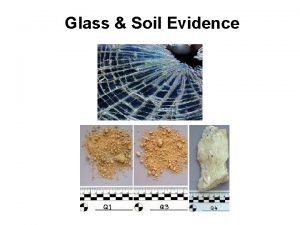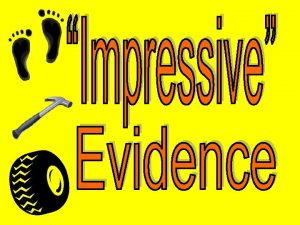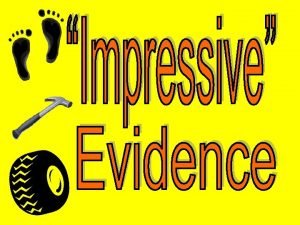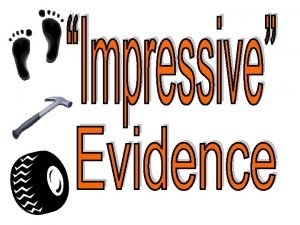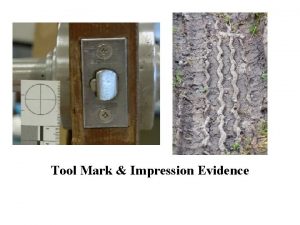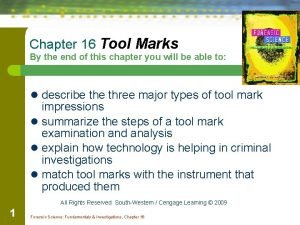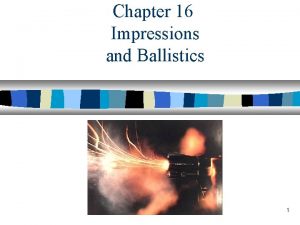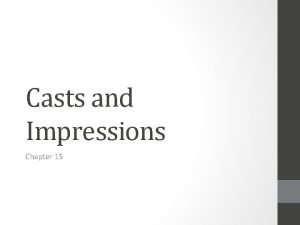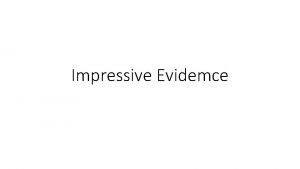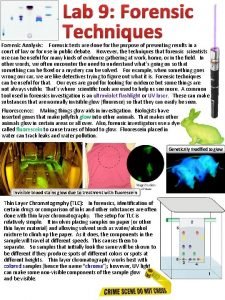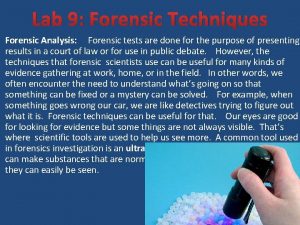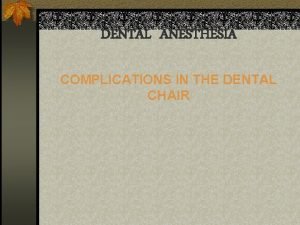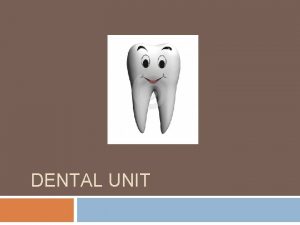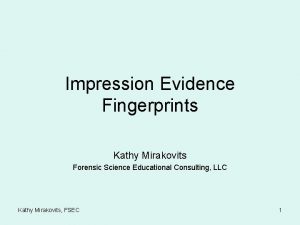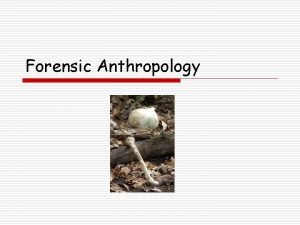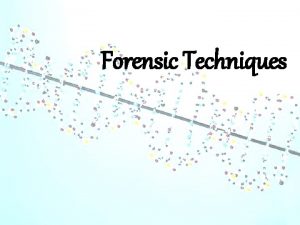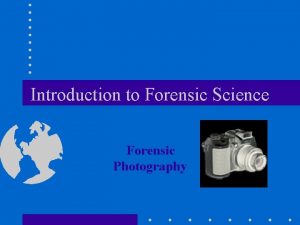Forensic Impression Evidence Shoeprint Analysis Dental Impression Analysis





























- Slides: 29

Forensic Impression Evidence Shoeprint Analysis Dental Impression Analysis Toolmark analysis

Footprint Evidence Found at approximately 40% of crime scenes Second to DNA as most common evidence found Useful in proof of presence at a crime scene Also known as (a. k. a. ) shoe prints, footwear marks (interchangeable terms) • World’s oldest footprint estimated to be over 3 million years old was discovered in 2007 at Siwa Oasis in Egypt. • First recorded use of footprints in forensic investigation: early 1800’s in Warwick, England • •

Two types of impressions • Positive • Two dimensional – Created by a person transferring matter such as dust or blood from the shoe to a surface walked upon • Negative – Three dimensional – Impression created when shoe removes residue from the surface walked upon – Example: walking through mud or cement

O. J. Simpson’s Bruno Mali Shoes • Inculpatory or incriminating evidence: bloody footprint found at the crime scene • William Bodziak, FBI footprint analyst confirmed prints were from a size 12 Bruno Mali shoe • Shoes were rare in U. S. (only 299 pairs sold here). • At the time of presentation, prosecution had no proof that Simpson had purchased shoes. • Later, a tabloid photo surfaced showing Simpson wearing the shoes in question.

The Unabomber Case Theodore Kaczynski (a. k. a. unabomber) Life sentence without parole Bombing spree that lasted from 1978 to 1995 Evidence from his Montana cabin included shoes with fake soles • He attached soles from smaller sized shoe to his own shoe to mislead investigators • Plead guilty to crimes • •

Class characteristics of Shoe Prints • Unique to all shoes of a particular brand style – Outsole pattern – Symbols – Design features • Helps investigators to determine the manufacturer of the shoe • Type and brand is determined so that the exact size of shoe can be determined. • In some cases, a specific brand style of shoe used by the criminal can lead to exclusion of other brands and sizes.

Individual characteristics of Shoes • • Unique to the shoe Manufacturing irregularities Chips or holes in the tread Substances added to or removed from the shoe during wear: rocks, gum, tar, tacks, nails Cracks or warping due to wear Missing pieces of rubber Indentations created by objects that come in contact with the rubber. Help narrow down the search for a specific shoe.

Wear Pattern • Formed by the gradual wearing away of rubber due to friction between the walking surface and the sole. • Longer the shoe is worn = more pronounced the wear pattern • Wear more pronounced where the foot first makes contact with the ground. • Can be used to assess the walking pattern of the person – Wear pattern on outside rear near heel indicates the walker pronates or walks with supination (ankle turned out, away from the other foot) – Wear pattern on inside of the shoe towards toe indicates overpronation (walks with ankle turned in towards other foot) – Print that is uniform across the forefront indicates the wearer walks with neutral or normal pronation (foot contacts ground evenly).

Analysis • No minimum number of class or individual characteristics to establish identification – One characteristic alone can be used to identify a shoe – Must be clear, detailed, defined, and contain significant features in common with the impression – If similar characteristic were a simple hole or pinprick that could be easily found on multiple shoes then more identifying characteristics would be needed

Other Information Obtained from Shoeprints • Direction and rate of movement – Faster rate: deep prints with front of foot pressed deeper into ground than rest of print and long stride • Sex – Women: smaller prints that might be slightly pigeon-toed with a small stride – Men: tend to walk with toes pointed straight forward or tilted slightly outward • Whether the individual is aware that they are being tracked • Carrying something: print will appear consistently deeper on one foot

• Gait: stride length and width or distance between two heel prints of the same foot • Stride length used in correlation with shoe size can help estimate height. • Foot length is approximately 15% of the person’s height. • This ratio does not apply to 10 -20% of the population but can be used to narrow the field of suspects and give an idea of the individual being sought.

“What is not looked for will not be found. ” W. Bodziak • Recovering footprints is tedious. • All surfaces should be considered sources of prints. • Footprints are sometimes neglected at the crime scene. Emphasis is often on finding fingerprints • Every step taken by a person will leave a mark or impression of some type.

Processing the Scene • Are footprints relevant to what happened? • Where can footprints be found? – – Floors Paper Glass Cardboard • Use oblique light to help visualize prints • Use care not to disturb evidence. • What methods must be used? Often multiple techniques are required to lift the prints with least amount of distortion. • Photograph! Visual evidence of the original footprint before lifting showing relationship to the crime scene

Casting Use for 3 -dimensional footwear impressions “taking a mold” Provides true-to-size physical model If print is in sand or there is concern that print might be disturbed by casting, the print is sprayed with aerosol glue or hairspray to prep it. • Muddy prints: draw moisture away using pipette or a hair dryer. • https: //youtu. be/mquy. NZa. Nb. Po • https: //youtu. be/i. Cu. M 4 Wj. Jbh. I • •

• Two-dimensional prints may be found on – Glass, wood flooring , cardboard, fabric – Lift using a hydraulic press and gelatin lifters or electrostatic devices • Gelatin lifter: sheet of paper with a strong adhesive on one side used to lift print from most surfaces • Porous surfaces such as cardboard or fabric: hydraulic press is used to push down on the gelatin • Electrostatic devices: good for hard to access areas, carpeting, wood, fabric – Uses high voltage power unit to charge metallic film; matter forming the print clings to the film. Can be used on the human body.

• Surface and location of print may limit the amount of time in which the print can be lifted. – Prints in blood may last years. – Prints in water may evaporate. – Prints in sand can be brushed away. – Sometimes this results in a hurried processing and lifting of prints.

Tire Treads and Impressions • To collect and preserve tire tread impressions, the same procedures as shoe prints should be done. – Photograph the original tire print before processing – Place casting dam around the imprint – Mix the casting material according to instructions – Pour casting material into impression along the sides and allow it to flow into the impression – Allow the casting to set for at least 60 minutes before attempting to remove. Package in cardboard box with appropriate labels/information. Send to lab.

Dental Impressions and Bite marks • Forensic odontology (forensic dentistry): combines dentistry with law enforcement • Primary duty is human identification • Examine evidence from cases involving violent crime, child abuse, elder abuse, missing persons, and mass disasters • Helps identify victims, suspects, and establish leads in an investigation

• Perpetrators often leave behind evidence: – Bitten food – Chewed objects – Bite marks on the skin of a victim

• Majority of a forensic dentists work falls into two areas or types of cases: – Missing and unidentified persons – Recognition, documentation and preservation of bite mark evidence • Important when fingerprints cannot be obtained from skeletonized remains • Help to place a suspect at a scene or identify the perpetrator of a violent crime

Dental Evidence • Anything that relates to human dental anatomy or coming from the oral cavity – Tooth shape – Metal restorations such as crowns and fillings – Skull and jawbone irregularities – Skull fragments – Teeth marks in the skin, soft objects such as gum, food – Most famous bite mark of the 20 th century was the one of Ted Bundy.

• During a violent crime, both the victim and perpetrator may bite during the assault. – Photograph – Impressions taken to get a 3 -D model – Analyze bite pattern – Immediately document as soon as marks are noticed because if the victim is alive, natural healing will cause the bruises and cuts from the bite to disappear.

Bite Mark Analysis • Attempt to connect biter to the pattern left behind on a person or object which is linked to a crime – Two assumptions: • Characteristics of the teeth involved in the biting are unique in all individuals • Uniqueness is transferred and recorded in the injury • Note: ability of skin to register sufficient detail varies; bite marks may be distorted or not well defined • May be used in inclusion or exclusion of suspects • Difficult to identify a single individual as the biter

• The CSI or medical examiner must recognize that the wound on a victim is a bite mark. – Typical bite mark is somewhat circular or oval. – Two opposing, symmetrical U-shaped arches – Along the margin of the arches are round or almost circular bruises • Used to identify size, shape, arrangement and distribution of the surfaces of the teeth in contact with skin • May not always have a complete set of marks if the bite was obstructed by an object such as a sleeve.

• Human teeth are arranged in a predictable pattern. • Variations in size, shape, position as well as wear from chewing, dental health and treatment give each person a “unique” dental profile. – Teeth change during a person’s lifetime. (braces, extraction, decay/fillings, crowns)

Evaluating the Bite Mark • Criteria: – Front teeth are the primary biting teeth in bite marks • Six upper and six lower front teeth (central and lateral incisors and the cuspids) – The upper jaw (maxilla) is wider than the lower jaw (mandible). – A bite mark showing upper and lower front teeth will show a total of 12 teeth marking the skin.

Upper jaw (maxilla) Central incisors Lateral incisors Cuspids (canine) First premolar 2 nd premolar 1 st molar Lower Jaw (mandible) 2 nd molar 3 rd molar (wisdom)

Steps in Evaluating Marks • Determine which marks were made from upper and lower teeth – – Upper front 4 teeth make rectangular marks. Central incisors are wider than lateral incisors Upper and lower cuspids leave round or oval shaped marks Lower front 4 teeth make rectangular marks Spaces or gaps may indicate a missing tooth. Fainter bruising in bite mark: less pressure from the teeth possible due to some feature on the tooth such as chipping or tooth that is shorter than neighboring teeth or an object such as clothing that interfered. Skin may be torn or moved during biting.

• Measure distances between teeth marks. Do this for teeth that are adjacent to each other as well as opposite each other. • Exemplars from suspect are compared to victim’s bite marks. Exemplars may be taken from the suspect using dental casting to make a mold of the teeth. • Photograph the suspects teeth too.
 Forensic pathologist vs forensic anthropologist
Forensic pathologist vs forensic anthropologist Who is this
Who is this Tyre impression forensic science
Tyre impression forensic science Dental impressions courses
Dental impressions courses Classification of impression materials
Classification of impression materials Forensic recovery of evidence device
Forensic recovery of evidence device Example of conditional evidence
Example of conditional evidence Types of physical evidence in forensic science
Types of physical evidence in forensic science Glass evidence in forensic science
Glass evidence in forensic science Forensic duplication tools
Forensic duplication tools Kathleen peterson forensic evidence
Kathleen peterson forensic evidence Forensic evidence
Forensic evidence What is impression evidence
What is impression evidence What is impression evidence
What is impression evidence What are the features to analyze on shoe print evidence?
What are the features to analyze on shoe print evidence? Impression evidence examples
Impression evidence examples Types of impressions
Types of impressions Abrasion marks forensics
Abrasion marks forensics Impression evidence
Impression evidence Types of tire marks
Types of tire marks What is a primary source
What is a primary source Primary evidence vs secondary evidence
Primary evidence vs secondary evidence Primary evidence vs secondary evidence
Primary evidence vs secondary evidence Primary evidence vs secondary evidence
Primary evidence vs secondary evidence Primary evidence vs secondary evidence
Primary evidence vs secondary evidence Fiber evidence can have probative value.
Fiber evidence can have probative value. Class vs individual evidence
Class vs individual evidence Difference between class evidence and individual evidence
Difference between class evidence and individual evidence Class and individual evidence
Class and individual evidence Ecological fallacy
Ecological fallacy


